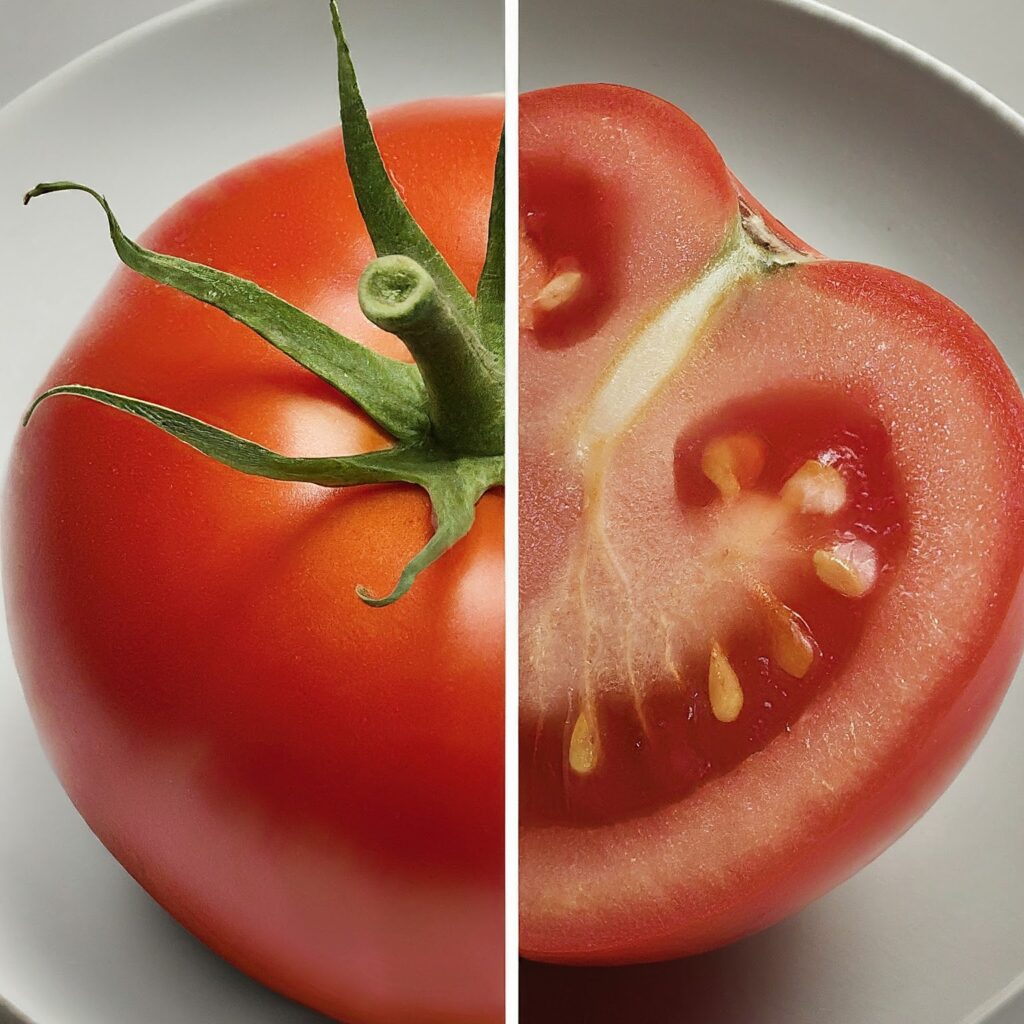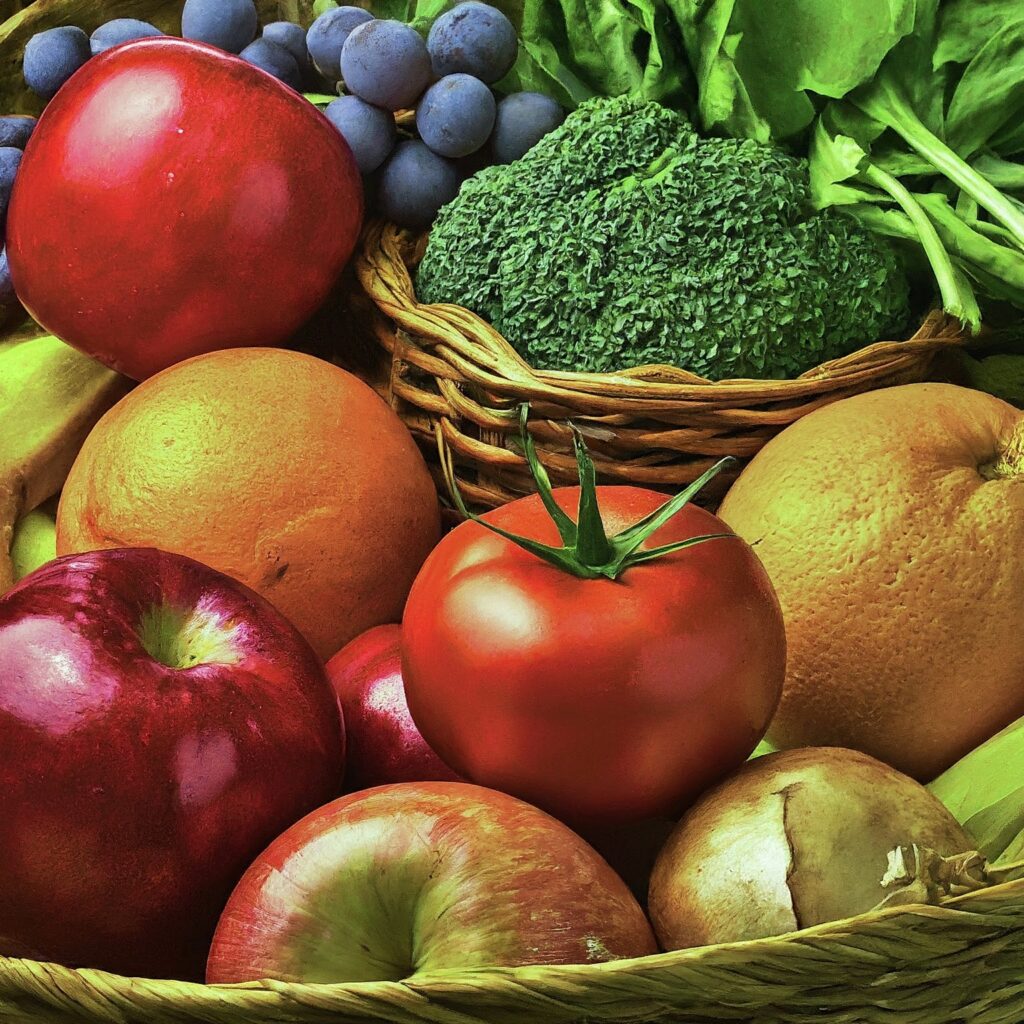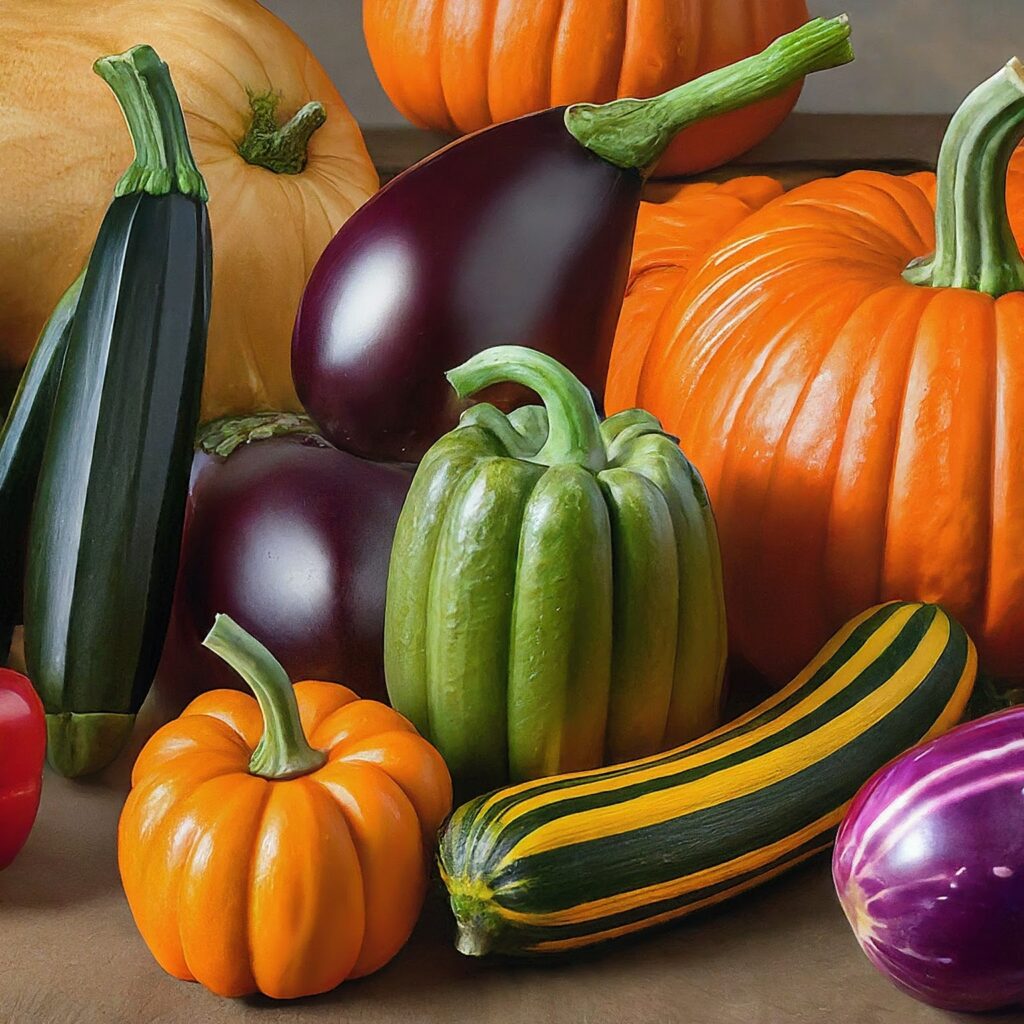Is Tomato a Fruit or Vegetable?
Ah, the age-old debate: Is tomato a fruit?
A tomato is technically a fruit—it develops from the ovary of a tomato flower and contains seeds. This puts it in the same category as other fruits, as per plant biology.
But here’s where it gets interesting: once tomatoes hit the kitchen, things change. They’re often treated more like vegetables.
Why?
Well, it’s because they’re commonly used in savory dishes, where their tanginess, texture, and flavor add depth to all sorts of recipes.
What Makes Tomato Both Fruit and Vegetable?

When you think about it, the journey of a tomato—from blossom to table—is quite remarkable. Starting as a delicate flower, it undergoes pollination and fertilization to form the first tiny fruit.
As the fruit matures, it swells and ripens, ready to be plucked from the vine. This transformation, from a humble flower to a vibrant red fruit, is a testament to the wonders of nature.
Transitioning from the garden to the kitchen, you’ll find tomatoes taking on new roles and flavors. They lend their sweetness and tanginess to sauces, soups, and stews, infusing each dish with their distinct taste.
Whether roasted, grilled, or simply sliced fresh, tomatoes elevate the culinary experience with their versatility and depth of flavor.
But why the culinary discrepancy? Why are tomatoes hailed as fruits in one context and embraced as vegetables in another?
The answer lies in the intersection of science and culture. While botanically classified as fruits due to their seed-bearing nature, tomatoes are treated as vegetables in cooking because of their savory profile and common usage in savory dishes.
Consider the classic caprese salad, where juicy slices of tomato mingle with creamy mozzarella and fragrant basil, drizzled with olive oil and balsamic vinegar. Here, the tomato’s acidity balances the richness of the cheese, creating a harmonious blend of flavors and textures.
Or think about a hearty tomato soup on a chilly evening, warming you from the inside out with its robust tomato flavor and comforting aroma. Paired with a crusty slice of bread or a grilled cheese sandwich, it’s a simple yet satisfying meal that soothes the soul.
So, the next time you’re pondering the age-old question, “Is Tomato a fruit?” remember that the answer isn’t black and white. It’s a nuanced interplay of science, culture, and culinary tradition.
Whether you classify tomatoes as fruits or vegetables, one thing remains undeniable: they’re a delicious addition to any garden and kitchen alike.
Related post: How to Grow Tomatoes
Fruit vs. Vegetable – Key Differences

Let’s unravel the mystery of fruits and vegetables together because this aspect contributes much to the tomato debate.
Botanical Categorization
Alright, let’s explore the plant world together. In nature, fruits are like treasure chests, full of surprises. They’re the mature ovaries of flowering plants, packed with seeds ready to sprout new life. When pollination works its magic, these fruits burst forth in all their colorful glory.
On the flip side, we have vegetables—the unsung heroes of the plant kingdom.
While fruits steal the show with their vibrant colors and juicy insides, vegetables quietly support the rest of the plant. From roots keeping the plant grounded to leaves soaking up the sun, vegetables cover all the other tasty parts.
Now, we know all this talk about plants might sound a bit like a science lesson, but trust us, it’s important stuff for any budding gardener.
Understanding the difference between fruits and vegetables not only helps you appreciate nature’s wonders but also guides your gardening decisions.
So, as you dig into your gardening adventure, remember the story of fruits and vegetables—it’s a tale of growth, life, and deliciousness.
Culinary Categorization
Now, let’s head to the kitchen—the heart of culinary magic. Here’s where things get a bit fuzzy.
See, in the culinary world, we’re not so concerned about plant anatomy. We’re more interested in taste and how we use ingredients in our cooking. That’s where the real fun begins.
In the culinary realm, fruits often play the role of sweet starlets. You know, those juicy, sweet delights like apples, oranges, and berries. They’re the superheroes of desserts, shining bright in pies, tarts, and smoothies.
Vegetables, on the other hand, are the unsung heroes of savory dishes. They’re the backbone of soups, stews, and stir-fries, adding depth and flavor to every bite. Think leafy greens, root veggies, and all those colorful bell peppers—they’re the real MVPs of the kitchen.
But here’s where it gets juicy—pun intended.
What about those sneaky fruits that masquerade as vegetables? Yep, we’re talking about tomatoes, cucumbers, and bell peppers. Sure, they’ve got seeds, technically making them fruits in the botanical world. But in the kitchen, they’re the unsung veggies, starring in everything from salads to sauces.
This culinary conundrum shows us that sometimes, you’ve got to blur the lines between science and taste buds. It’s all about embracing the delicious diversity of nature’s bounty and getting creative in the kitchen.
So, next time you’re slicing up a tomato for your salad or throwing some bell peppers into a stir-fry, remember—you’re not just cooking, you’re celebrating the wondrous world of fruits and vegetables in all their flavorful glory.
Botanically, Tomato is a Fruit
According to botanists, tomatoes undeniably fall into the fruit category. They develop from the ovary of the tomato flower and contain seeds, meeting all the criteria of a botanical fruit. So, technically speaking, tomatoes are fruits.
But hold on, before you start tossing tomatoes into your fruit salad, let’s consider the culinary perspective.
In the Culinary World, Tomato is a Vegetable
In the culinary world, tomatoes are predominantly used in savory dishes. They add depth of flavor to salads, sauces, soups, and countless other savory creations. Because of their taste and culinary usage, tomatoes are often classified as vegetables by chefs and home cooks alike.
Explore the differences between determinate and indeterminate tomatoes.
Supreme Court of United States Ruling on Whether Tomato is a Fruit or Vegetable
You might be surprised to learn that the tomato’s status as a fruit or vegetable was once the subject of a legal dispute in the United States. In the 1893 case of Nix v. Hedden, the Supreme Court unanimously ruled that tomatoes should be considered vegetables for customs regulations purposes.
The decision was based on how tomatoes were commonly used in cooking and how they were perceived by the general public. Despite their botanical classification as fruits, the court deemed tomatoes to be vegetables due to their culinary role.
Other Fruits That are Often Considered Vegetables

Tomatoes aren’t the only fruits that find themselves masquerading as vegetables in the culinary world. Several other fruits blur the lines between sweet and savory, including:
- Cucumbers
- Bell peppers
- Eggplants
- Avocados
- Pumpkins
- Squash (including zucchini)
- Olives
- Peapods (technically legumes but often treated as vegetables)
- Okra
These fruits share a similar fate as tomatoes, often finding their way into savory dishes despite their botanical classification.
Final Verdict – Is Tomato a Fruit?
So, back to our initial question: Is tomato a fruit?
The answer depends on who you ask and in what context.
Simply put, from a botanical perspective, tomatoes are fruits.
However, in the kitchen, they’re vegetables due to their savory nature.
Ultimately, whether you consider tomatoes fruits or vegetables is a matter of perspective. But no matter how you classify them, one thing’s for sure: they’re a versatile and delicious addition to any garden and kitchen alike.
Happy gardening, and may your tomato plants yield bountiful harvests!

